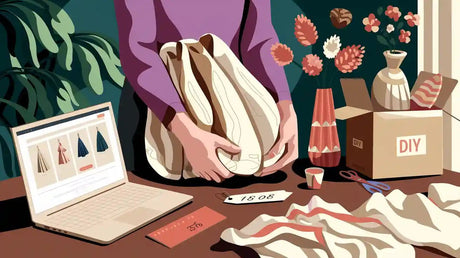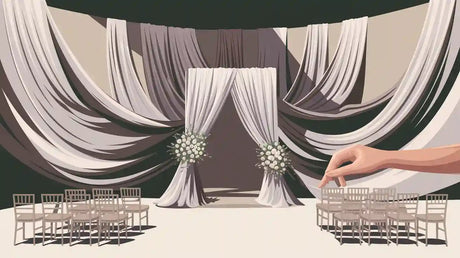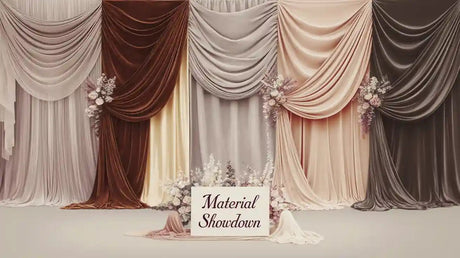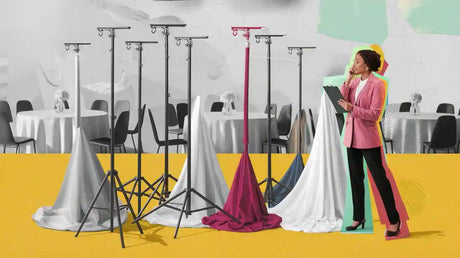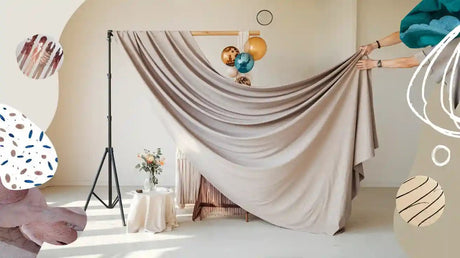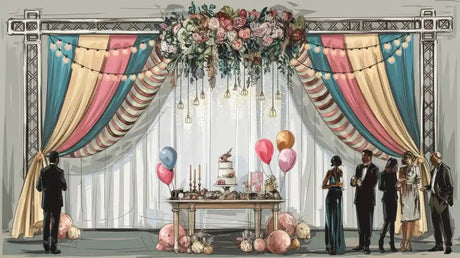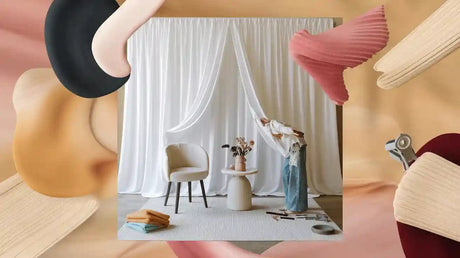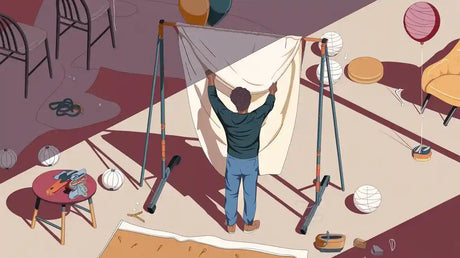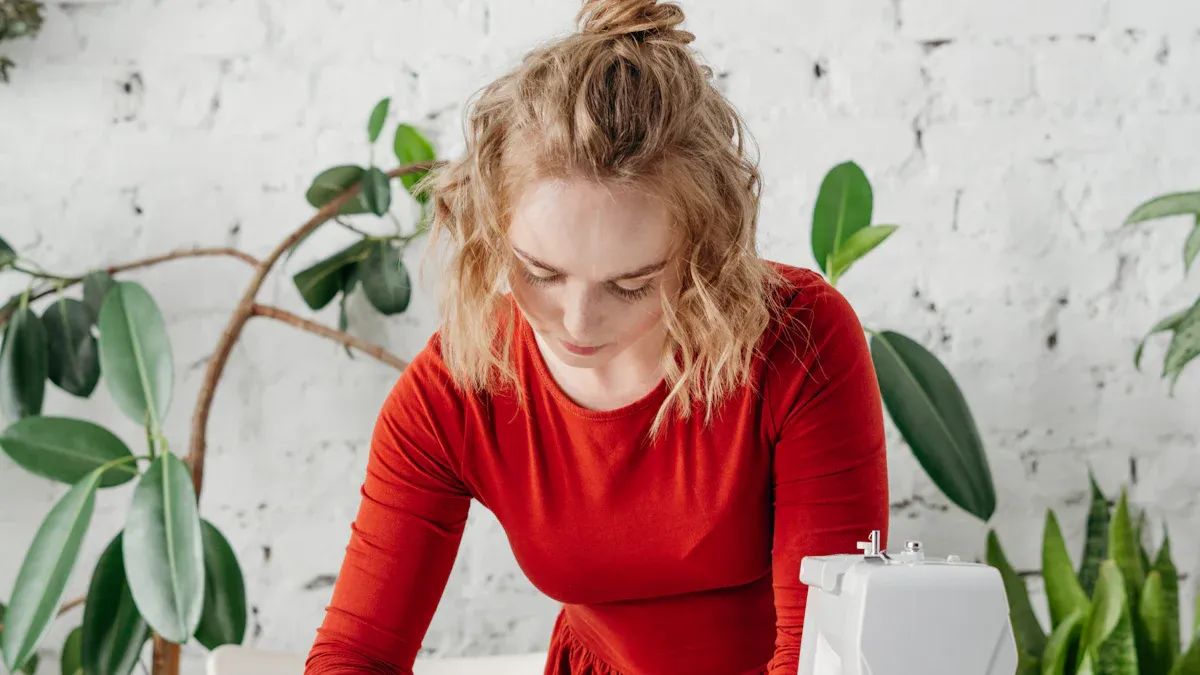
Have you ever had trouble finding a tablecloth that fits? A fitted tablecloth can fix that and make your table look nice. Making one yourself is useful, fun, and satisfying. You can pick the fabric, adjust the size, and even add elastic to keep it tight.
To make a fitted tablecloth, you measure the table, cut fabric, and sew it. Clear steps and measurements help you through the process.
DIY fitted tablecloths are becoming popular, with free patterns for many styles. Whether for a dining table or craft table, this project lets you make something special.
Key Takeaways
Pick the right fabric based on how you'll use it. Cotton-polyester blends work well for daily use. Oilcloth is great for outdoor events.
Measure your table carefully. Check its length, width, and height. Add extra fabric for seams to ensure a good fit.
Use simple sewing tools like tape measures, scissors, and pins. These tools make sewing easier and more fun.
Add elastic to your tablecloth for a tight fit. This helps it stay in place and look tidy, especially on round tables.
Finish with a neat hem. You can add lace or ribbons to make it unique and special.
Materials and Tools for a DIY Fitted Tablecloth
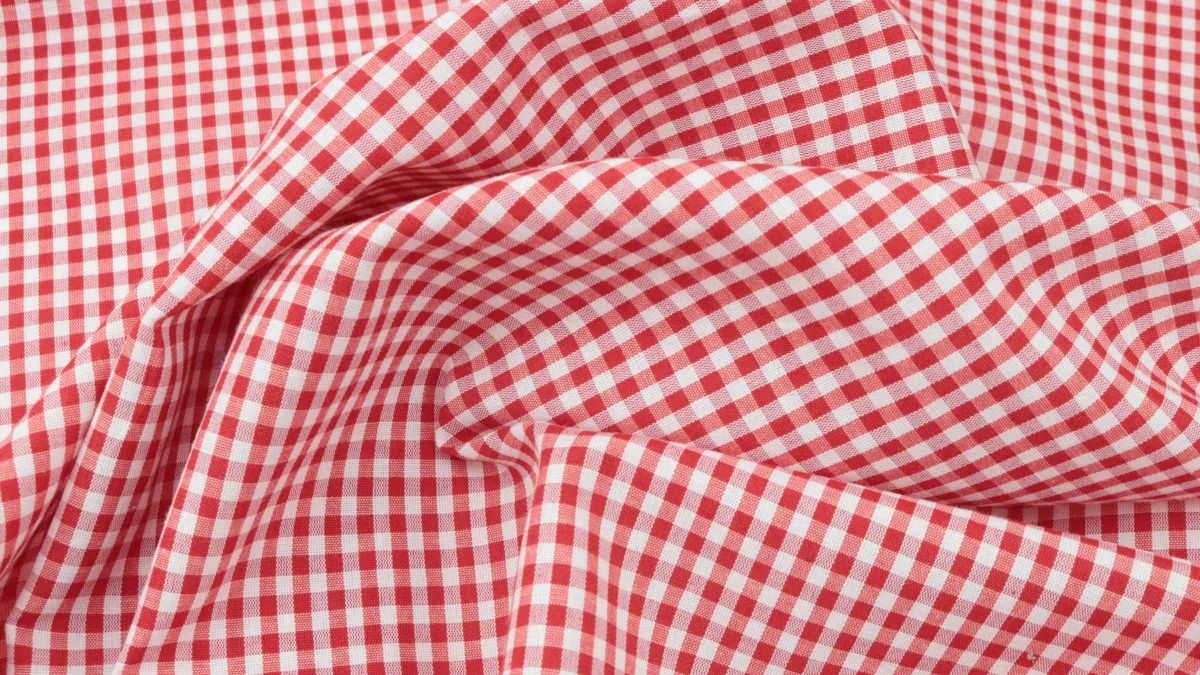
Picking the best fabric
The fabric you pick affects how your tablecloth looks and lasts. For daily use, cotton or polyester blends are great choices. They are strong, easy to clean, and come in many designs. If you need waterproof fabric, try oilcloth or vinyl-backed options. These are tough, don’t tear easily, and work well for outdoor tables or messy tasks.
Here’s a simple chart of common fabric types:
Fabric Type |
Best For |
Key Features |
|---|---|---|
Cotton |
Everyday use |
Soft, breathable, easy to sew |
Polyester blends |
Versatility |
Wrinkle-resistant, durable |
Oilcloth |
Outdoor or messy activities |
Waterproof, easy to wipe clean |
Linen |
Formal settings |
Elegant, natural texture |
Think about how you’ll use the tablecloth before choosing fabric. Polyester or oilcloth is great for heavy use. Linen is perfect for fancy occasions.
Basic tools for sewing
To make a fitted tablecloth, you’ll need some basic tools. These tools help you measure, cut, and sew neatly:
Measuring tape: To measure your table correctly.
Scissors: Sharp scissors make cutting fabric easier.
Pins: Hold fabric in place while sewing.
Sewing machine: Makes sewing faster and stitches neater.
Iron: Helps press seams for a clean finish.
Having these tools ready will make sewing easier and more fun.
Extra materials for a personal touch
Want to make your tablecloth special? Add some extras to make it unique. Elastic is great for keeping the edges snug, especially for round tables. You can also use trims like lace or ribbon for decoration.
Did you know most people love personalized items? Adding your own style makes the tablecloth special and shows your creativity. Here are some ideas:
Elastic for a tight fit.
Trims like lace, pom-poms, or fringe.
Fabric paint or stencils for custom designs.
These extras aren’t required but can make your project stand out and feel special.
Measuring Your Table for a Fitted Tablecloth
Before making a fitted tablecloth, measure your table correctly. This step helps your tablecloth fit well and look neat. Follow these easy steps.
Measuring the length and width
First, measure your table's length and width. Use a soft measuring tape that doesn’t stretch. Place the tape at one edge and pull it to the other side. Write down both the length and width measurements. If your table has rounded edges, measure the widest parts to fit the shape.
For a rectangular table, these numbers are very important. They help you cut the fabric right and avoid wasting it.
Measuring the height and adding seam allowance
Now, measure your table’s height. This is from the tabletop to the floor or where you want the cloth to end. Add 1–2 extra inches for seam allowance. Seam allowance is extra fabric for folding and sewing neat edges. Without it, the tablecloth might be too short.
If you want your tablecloth to fit snugly, this step is important. Adding extra fabric makes sewing easier and gives a better fit.
Tips for accurate measurements
Here are some tips to measure your table easily and correctly:
Use a soft tape for curved or odd edges.
Check your measurements twice before cutting fabric.
Add a little extra space if you want a looser fit.
Always include seam allowance for clean, finished edges.
Measuring carefully is very important for a fitted tablecloth. Even small mistakes can ruin the fit, so take your time and do it right.
How to Create a Fitted Tablecloth: Cutting the Fabric
Once you've measured your table, it's time to cut the fabric. This step is crucial for ensuring your DIY fitted tablecloth fits perfectly. Follow these step-by-step instructions to get it right.
Marking the fabric for precision
Start by laying your fabric flat on a clean, smooth surface. Use a fabric marker or chalk to outline the dimensions you measured earlier. For straight edges, a ruler or yardstick can help you draw precise lines. If you're working with a circular table, try using a compass or a circular template. These tools are known for their accuracy and can save time. In fact, a survey found that 78% of quilters prefer circular templates for cutting circles because they ensure consistency.
Take your time with this step. Clear markings will make the next steps much easier and help you avoid mistakes.
Cutting straight lines
Cutting the fabric neatly is just as important as marking it. To achieve straight lines, follow these steps:
Fold one corner to the opposite edge to create a right triangle.
Trim away the excess fabric to form the triangle.
Cut along the fold to separate the two layers.
Stack the triangles and cut strips along the hypotenuse if needed for piping or decoration.
This method ensures clean edges and reduces the chance of uneven cuts. Always use sharp scissors or a rotary cutter for the best results.
Double-checking dimensions
Before moving on, double-check your work. Lay the fabric over your table to see if it matches the measurements. If something seems off, now's the time to fix it. Remember, it's easier to adjust before sewing than after. Measuring twice and cutting once is a golden rule in sewing, and it applies here too.
By carefully marking, cutting, and checking your fabric, you'll set yourself up for success. These steps are key to learning how to create a fitted tablecloth that looks professional and fits like a glove.
Sewing the Corners of Your Fitted Tablecloth
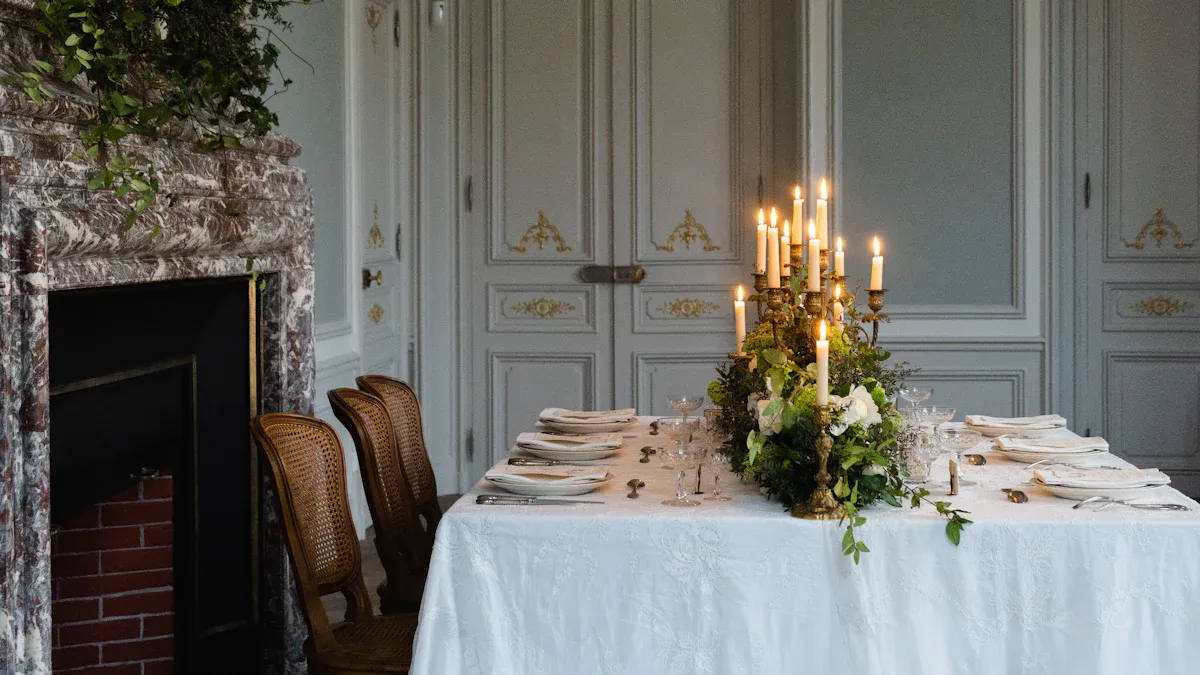
Once you've cut your fabric, it's time to tackle the corners. This step is where your tablecloth starts to take shape. Sewing the corners properly ensures a snug fit and gives your tablecloth a polished look.
Pinning the fabric for fitted corners
Start by pinning the fabric at each corner. Lay the fabric on your table, ensuring the right sides are facing each other. Align the edges of the fabric at the corners, and use pins to hold them in place. This keeps the fabric from shifting while you sew.
Tip: Cut a square of fabric at each corner using the height measurement plus seam allowance. This makes it easier to align the edges and reduces bulk when sewing.
If you're working with a rectangular or square table, this step is straightforward. For round tables, you may need to adjust the fabric slightly to match the curve.
Sewing and trimming for a snug fit
Now it's time to sew! Use a straight stitch to sew along the pinned edges. Keep your stitches even and follow the seam allowance you added earlier. If you want a professional finish, try creating a mitered corner by folding the fabric diagonally before stitching.
Once you've sewn the corners, trim any excess fabric. This reduces bulk and helps the corners lay flat. Be careful not to cut too close to the stitches.
Pro Tip: Finish the raw edges with a zig-zag stitch or a serger. This prevents fraying and keeps your tablecloth looking neat over time.
Ensuring clean and professional edges
Clean edges make all the difference in how your tablecloth looks. Use an overlock or serger to secure the edges and prevent fraying. If you don’t have a serger, a zig-zag stitch works just as well.
Recommendation |
Importance |
|---|---|
Minimizes fraying and maintains fabric integrity. |
|
Encapsulation by thread |
Prevents fraying and ensures a polished, professional finish. |
Take a moment to inspect your work. Are the corners smooth? Do the edges look clean? If something seems off, make adjustments now. A little extra effort here will make your tablecloth look like it was made by a pro.
Adding Elastic to Your Fitted Tablecloth (Optional)
Elastic can make your tablecloth fit better and stay in place. It’s helpful during meals or crafts when the tablecloth might move. If you’re unsure about using elastic, here’s why it’s a good idea and how to add it.
Why elastic is useful
Elastic has many benefits that improve your tablecloth. Here’s a simple list:
Benefit |
What It Does |
|---|---|
Keeps the tablecloth tight and stops it from slipping. |
|
Neat Look |
Makes the tablecloth look smooth and tidy for any event. |
Easy to Maintain |
Stays in place, so you don’t have to fix it often. |
Elastic helps your tablecloth stay put, even outside where wind can be a problem. It also gives your table a clean and polished look.
Tip: Elastic works great for round tables because it fits evenly around the edges.
How to sew elastic onto your tablecloth
Adding elastic is simple if you follow these steps. First, cut elastic to match your table’s edge. Stretch it a little while measuring for a snug fit.
Steps to attach elastic:
Fold the fabric edge over the elastic to make a pocket.
Pin the fabric to hold the elastic in place.
Sew with a zig-zag stitch, gently stretching the elastic as you sew.
This method keeps the elastic flexible and holds the fabric tightly. If you’re new to sewing, practice on scrap fabric first to get comfortable.
Adjusting elastic tension
The right tension makes your tablecloth work well. If it’s too tight, the fabric may bunch up. If it’s too loose, the tablecloth won’t stay put.
To fix the tension:
Stretch the elastic slightly while sewing, but not too much.
Test the fit on your table before finishing the seam.
Adjust by loosening or tightening the elastic as needed.
Note: Medium-stretch elastic works best. It stays flexible and keeps its shape over time.
Elastic makes your tablecloth look better and work better. It’s an easy way to upgrade your project and make it more useful.
Hemming and Finishing Touches for a Fitted Tablecloth
Folding and sewing the edges
To make your tablecloth look neat, fold the edges. Fold about half an inch of fabric inward on all sides. Then, fold it again to hide the rough edges. This double fold stops fraying and gives a clean finish. Use pins to keep the folds in place as you go.
After pinning, sew along the inner edge of the fold with a straight stitch. Keep your stitches even and close to the edge for a tidy look. If you’re new to sewing, take your time. A good hem is key to making your tablecloth look polished.
Adding decorative elements
Decorations can make your tablecloth look extra special. Add trims like lace, pom-poms, or colorful ribbons to the edges. These small touches can make a big difference, especially for parties or holidays.
Think about using eco-friendly materials for decorations. Many people now prefer sustainable items. For example, cotton lace or recycled trims are great choices. Seasonal designs are also popular. During holidays like Christmas, festive tablecloths sell more. Adding holiday-themed decorations can make your tablecloth perfect for special events.
Trend |
Description |
|---|---|
Sustainability |
Eco-friendly materials are popular, especially with younger people. |
Seasonal Demand |
Holiday designs are loved for festive occasions. |
Final inspection and adjustments
Before finishing, check your tablecloth carefully. Lay it flat and look for uneven hems or loose threads. Fix any problems you find. A quick trim or extra stitch can make it look better.
Test the fit by placing the tablecloth on your table. Does it fit well? Are the corners smooth? If you added elastic, check that it holds the fabric tightly without bunching. Spending a little extra time on these checks ensures your tablecloth looks great and works perfectly.
By doing these final steps, you’ll have a tablecloth that’s both useful and beautiful for your home.
Making a tablecloth that fits perfectly is easier than you might think. By following these steps, you can create a custom piece that matches your style and fits your table like a glove. Whether you choose bold fabrics, add elastic, or keep it simple, the result will be uniquely yours. Plus, the satisfaction of crafting something with a perfect fit is hard to beat. So, grab your tools, pick your fabric, and start sewing. Your table will thank you!
FAQ
How do I choose the best fabric for my tablecloth?
Pick a fabric based on how you’ll use the tablecloth. For everyday use, cotton or polyester blends work well. For outdoor or messy activities, waterproof options like oilcloth are ideal. Always consider durability and ease of cleaning.
Can I make a fitted tablecloth without a sewing machine?
Yes, you can! Use fabric glue or hand-stitching for small projects. While a sewing machine speeds up the process, hand-sewing can still give you great results. Just take your time and ensure your stitches are secure.
What’s the easiest way to measure a round table?
Use a soft measuring tape. Measure the diameter by stretching the tape across the widest part of the table. Add extra inches for seam allowance and any overhang you want. Double-check your measurements for accuracy.
How do I prevent my tablecloth from slipping?
Adding elastic to the edges is the best way to keep your tablecloth in place. It ensures a snug fit and prevents slipping, even during outdoor use. You can also use non-slip pads underneath for extra grip.
Can I wash my DIY tablecloth in a machine?
It depends on the fabric. Most cotton and polyester blends are machine washable. Waterproof fabrics like oilcloth should be wiped clean instead. Always check the fabric care instructions before washing.

